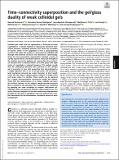| dc.contributor.author | Keshavarz, Bavand | |
| dc.contributor.author | Rodrigues, Donatien Gomes | |
| dc.contributor.author | Champenois, Jean-Baptiste | |
| dc.contributor.author | Frith, Matthew G | |
| dc.contributor.author | Ilavsky, Jan | |
| dc.contributor.author | Geri, Michela | |
| dc.contributor.author | Divoux, Thibaut | |
| dc.contributor.author | McKinley, Gareth H | |
| dc.contributor.author | Poulesquen, Arnaud | |
| dc.date.accessioned | 2022-01-11T17:49:17Z | |
| dc.date.available | 2022-01-11T17:49:17Z | |
| dc.date.issued | 2021 | |
| dc.identifier.uri | https://hdl.handle.net/1721.1/138880 | |
| dc.description.abstract | Colloidal gels result from the aggregation of Brownian particles suspended in a solvent. Gelation is induced by attractive interactions between individual particles that drive the formation of clusters, which in turn aggregate to form a space-spanning structure. We study this process in aluminosilicate colloidal gels through time-resolved structural and mechanical spectroscopy. Using the time–connectivity superposition principle a series of rapidly acquired linear viscoelastic spectra, measured throughout the gelation process by applying an exponential chirp protocol, are rescaled onto a universal master curve that spans over eight orders of magnitude in reduced frequency. This analysis reveals that the underlying relaxation time spectrum of the colloidal gel is symmetric in time with power-law tails characterized by a single exponent that is set at the gel point. The microstructural mechanical network has a dual character; at short length scales and fast times it appears glassy, whereas at longer times and larger scales it is gel-like. These results can be captured by a simple three-parameter constitutive model and demonstrate that the microstructure of a mature colloidal gel bears the residual skeleton of the original sample-spanning network that is created at the gel point. Our conclusions are confirmed by applying the same technique to another well-known colloidal gel system composed of attractive silica nanoparticles. The results illustrate the power of the time–connectivity superposition principle for this class of soft glassy materials and provide a compact description for the dichotomous viscoelastic nature of weak colloidal gels. | en_US |
| dc.language.iso | en | |
| dc.publisher | Proceedings of the National Academy of Sciences | en_US |
| dc.relation.isversionof | 10.1073/PNAS.2022339118 | en_US |
| dc.rights | Article is made available in accordance with the publisher's policy and may be subject to US copyright law. Please refer to the publisher's site for terms of use. | en_US |
| dc.source | PNAS | en_US |
| dc.title | Time–connectivity superposition and the gel/glass duality of weak colloidal gels | en_US |
| dc.type | Article | en_US |
| dc.identifier.citation | Keshavarz, Bavand, Rodrigues, Donatien Gomes, Champenois, Jean-Baptiste, Frith, Matthew G, Ilavsky, Jan et al. 2021. "Time–connectivity superposition and the gel/glass duality of weak colloidal gels." Proceedings of the National Academy of Sciences of the United States of America, 118 (15). | |
| dc.contributor.department | Massachusetts Institute of Technology. Department of Mechanical Engineering | |
| dc.contributor.department | MultiScale Materials Science for Energy and Environment, Joint MIT-CNRS Laboratory | |
| dc.relation.journal | Proceedings of the National Academy of Sciences of the United States of America | en_US |
| dc.eprint.version | Final published version | en_US |
| dc.type.uri | http://purl.org/eprint/type/JournalArticle | en_US |
| eprint.status | http://purl.org/eprint/status/PeerReviewed | en_US |
| dc.date.updated | 2022-01-11T17:38:50Z | |
| dspace.orderedauthors | Keshavarz, B; Rodrigues, DG; Champenois, J-B; Frith, MG; Ilavsky, J; Geri, M; Divoux, T; McKinley, GH; Poulesquen, A | en_US |
| dspace.date.submission | 2022-01-11T17:38:52Z | |
| mit.journal.volume | 118 | en_US |
| mit.journal.issue | 15 | en_US |
| mit.license | PUBLISHER_POLICY | |
| mit.metadata.status | Authority Work and Publication Information Needed | en_US |
